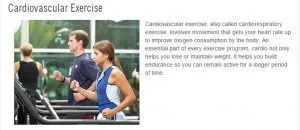“I need more cardio.” It’s a sentence that will make your strength coach wake up with a cold sweat in the darkest hours of the night. Well, not really, but it is something a lot of coaches are sick of hearing. When my clients approach me with this demand, they often struggle to articulate why they “need” it, just that they do. I know why they think they need it, and I’m going to explain why they don’t. It has been accepted as fact by the general public: Lifting weights is for building bigger muscles, doing cardio is for burning fat. This is a commonly accepted idea, although it couldn’t be further from the truth. First let us figure out exactly what “cardio” really is…
According to ACE, The American Council on Exercise, cardio is “movement that gets your heart rate up to improve oxygen consumption by the body.”

I had never heard of ANYONE refer to lifting weights as “cardio” though, but I could’ve sworn that my heart rate increased when I did a weight training session. I had to find out for myself, so I strapped on a heart rate monitor, and did a moderate intensity weight training workout. The results were surprising.
As you can see in the screen shot below, during an hour long weight training session I averaged 124 heart beats a minute. My resting heart rate is about 55, so that means lifting weights raised my heart rate by nearly 70bpm on average, with a peak heart rate of 158bpm. According to ACE’s definition, this was cardio!

Of course, I am being pedantic. What people really mean when they say “cardio” is aerobic exercise. Why? A long time ago it was discovered that fat cannot be burned without oxygen, and the word aerobic literally means “with oxygen,” (and it’s antithesis anaerobic means, you guessed it, “without oxygen”). In fact, it was recently revealed, that you literally expel fat when you breathe in and out! We have three primary pathways of energy when we exercise. When we do what most people consider “cardio” we usually are primarily using our aerobic energy system. But none of our energy systems completely shut off. That means even when your heart rate is very high, which is a more “anaerobic” zone, you are still burning energy with oxygen via the aerobic energy system. Why does it matter? Because even if your heart rate is higher than the aerobic “fat burning zone” when you lift weights, you still have fat burning effects from the training. So why be so fixated on the semantics of the vocabulary? What types of things do people think about when they hear the word cardio? Running, swimming, biking, etc…but the problem is, those activities can be anaerobic depending on the intensity and the duration of the workouts. In other words, “cardio” exercises can be aerobic, but not all aerobic exercises are cardio. Confused yet? Hopefully, not, but you may be wondering where rest time comes in to all of this. It’s simple, your strength training workouts can have a strong aerobic component to them as long as you are training at a specific intensity and using a certain amount of rest.
Pay Attention to your Rest Intervals
There is a big difference in the training effect of a workout where you rest 30 seconds between each set, and a workout where you rest 120 seconds between each set. Now before you skip the rest of the article and slash your rest times down to nothing in the gym, it’s important to know that there are benefits to longer rest intervals, and you’re going to learn when and why to use them. First let’s look at situations where you would want to keep your rest intervals short:
- Lower intensity workouts
- Intensity refers to the relative weight being used. The lighter the weight, the shorter the rest should be.
- You are training to improve your conditioning
- If you want to increase your ability to do a large volume of work in a short amount of time, taking a short rest is great for this.
- Your workouts are time restricted
- Your workout will take you a lot less time resting 45 seconds between each set, compared to a minute and a half.
https://www.instagram.com/p/B8zycPRHPdG/
Keeping the rest intervals short is a great way to make a low intensity workout challenging. We use this strategy a lot with newer clients. It’s not a great idea to have newer trainees lifting heavy weights, but you still want their workout to challenge them, and have a high energy output, thus we keep the intervals shorter. Next let’s take a look at why we use longer rest intervals:
- High intensity workouts
- Surprise! When you are lifting heavy weight, the goal is to MAKE the lift. This means you want to make sure you are sufficiently recovered between sets. If not could run the risk of injury, as lifting heavy weight when you’re tired should be reserved only for the most advanced athletes. It’s important to note, that even though your heart rate may not be elevated, it can take your muscles and the systems that provide them energy up to FIVE MINUTES to fully recover from a very heavy set.
- Your training is sport specific
- People think that the training of an athlete is 100% all out all of the time. If you’re an athlete who trains this way, stop it. In a professional football game, there is only an average of 11 minutes of game play during the 3+ hour period. That means it would be smart for a football player to train being explosive repetitively with longer rests, rather than a constant stream of movement, since that’s not how the game is actually played. Of course this is sport specific, the original football (Soccer!) is basically the antithesis of professional American football.
- You’re focused on technique
- When performing highly technical exercises that have a prominent skill component, it’s important to take significant rests to make sure that the technique is crisp, but also to allow time for your brain to compress the data during the learning process.
Circuit Training, Complexes and Supersets
There are a lot of ways to exercise. We don’t need to stick to “straight sets” where you perform an exercise for x amount of reps, and then rest. Let’s take a look at those options
Supersets
-
- This is where you perform two exercises back to back with no break in between. These are lauded because they “burn” and are hard, but I tend to use them I want to save the client time, by pairing together two exercises that don’t really jack the heart rate up, so there’s no real risk in putting them together.
Trisets
-
- Exactly what it sounds like, pairing three exercises together with no rest. I would consider this a “mini-circuit”
Circuit Training and “Giantsets”
-
- Technically a giant set would be more than 3 exercises done together in succession with no rest, where circuit training there is rest between each exercise, though it’s usually limited. Again people love circuits because they are hard, but I largely abandoned circuit training because it greatly limits the intensity (load) the client/athlete can use, making it difficult to progress. Due to the high energy output of circuit training, trainees usually see dramatic physical changes in the first few months of training, but the effects quickly wear off as their ability to progressively overload is limited by the fatigue that circuit training causes.
Complexes
-
- These stand out as it is a succession of exercises done with the same implement. These are great for their simplicity, as well as the small amount of space and equipment required to perform them.
https://www.instagram.com/p/B8BiNRsHCbV/
All of these training techniques have a time and place, and good coaches know when to use them without abusing them. It’s important to manipulate work to rest ratios in circuit training for different effects. Sadly, most “trainers” don’t know how to increase the output of different energy systems by manipulating these variables, they usually base their selection on what is “hard” or punishing for the client or athlete. In fact, I used to work at a facility that only used one interval protocol which was 60/15. That is 60 seconds of work, followed by 15 seconds of rest. It wasn’t until I introduced other work/rest ratios, as well as varying ways to manipulate the workout that they started to do anything differently. If you really want to test your coach, ask them what the difference is between a tabata and a 30/30 in terms of training effect.
Take Responsibility
There are few things more frustrating than when a client says that the program doesn’t seem challenging enough, or that it takes too long, when the truth of the matter is, they are completely ignoring their rest times between sets during their workout. All of the programs at Arkitect come with the rest time for every exercise. If you aren’t sticking to that number, you aren’t following your program. We highly encourage training with a stop watch, when you’re tired 60 seconds goes by a lot faster than you think! Furthermore, following the prescribed rest will help you build more muscle, better conditioning, and the magic unicorn everyone’s always looking for: burn more fat. Yes, it’s true, you can burn a ton of fat by lifting weights, as long as you aren’t lazy about it. Think about it: Would you rather spend 60 minutes running, or 60 minutes lifting weights? For most people, running for 60 unbroken minutes isn’t realistic. Also consider that’s an entire hour of your day devoted to working your muscles only one way. With weight training you have varied and dynamic movement. This means you can train your body in different positions and planes of movement, giving you a much more well rounded workout, and limiting the chances to develop muscular imbalances. When I chastise people for only running, and they remark that I “only lift weights” I like to point out that the correct analogy would be if someone only bench pressed. Runners often like to say that they do “cross training” which usually entails trail running, or hill sprints, and again the analogy here would be doing bench press, along with incline bench press.
- It’s important to note that I am not against running. In fact, I think it’s fantastic exercise. It’s an essential human movement and function, one that most of us lose the ability to do efficiently (myself included) throughout our lives. The point here, is that people often not give strength training a fair shake. If your goal is purely fat loss, or general health and fitness, a smart, solid strength training program needs to be the backbone of your program, with the rest time being a controlled and observed variable. Strength training will build healthy muscle, improve bone density, increase your resting metabolism, aid in flexibility and mobility, and just make you more of a bad ass, but only if you keep your rest times on point! No one wants to be that guy that brags about spending 3 hours in the gym every day, only to have worked through a handful of exercises because he was too busy chatting for 5 minutes between every set. Most exercises will take 60 seconds at most to complete (and that’s when the reps are at 15+), if you’re doing 6 exercises, with 3 sets per exercise, that’s 18 minutes of work. Factor in 60 seconds of rest between each set, that’s another 18 minutes. Give yourself 15 minutes to warm-up, and 15 minutes to cool down (which is being generous), and you can get a serious calorie burning workout done in just over an hour (66 minutes). So do the work, get lean, be strong, and have fun!



